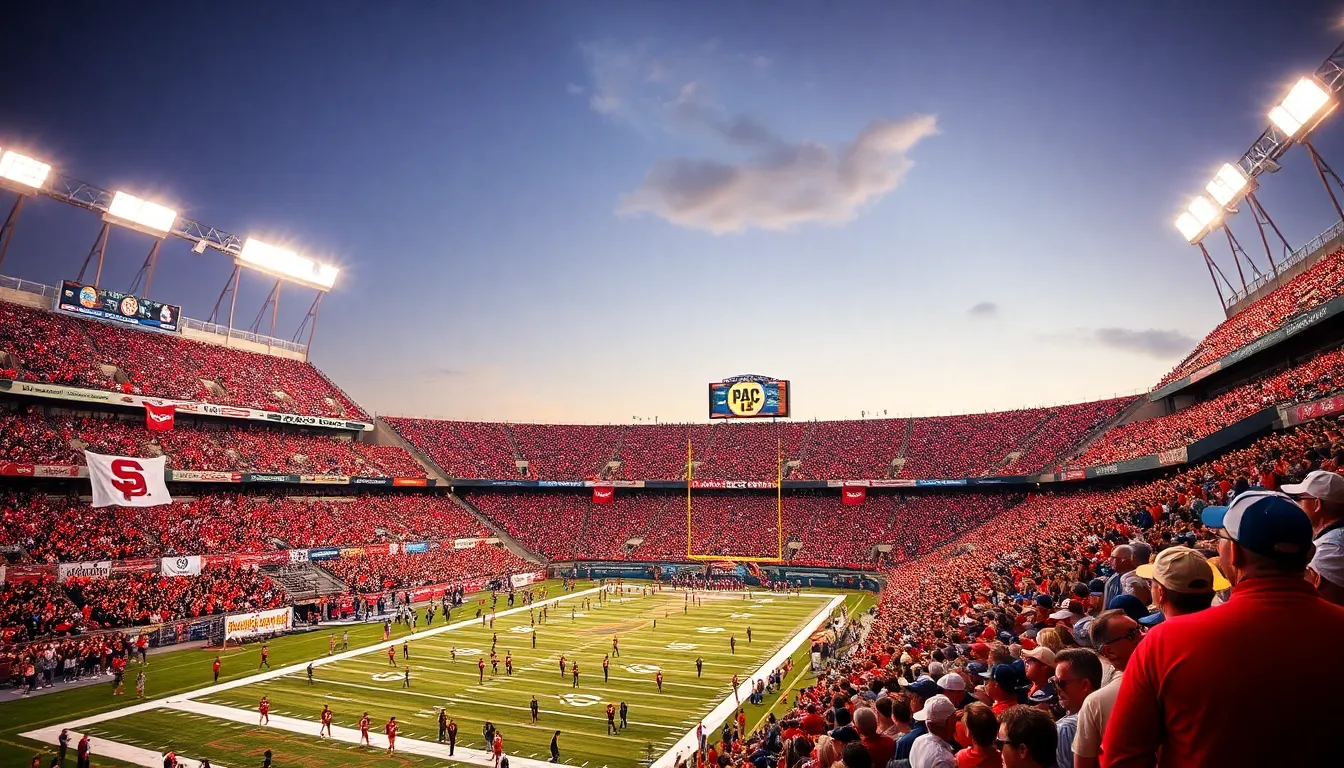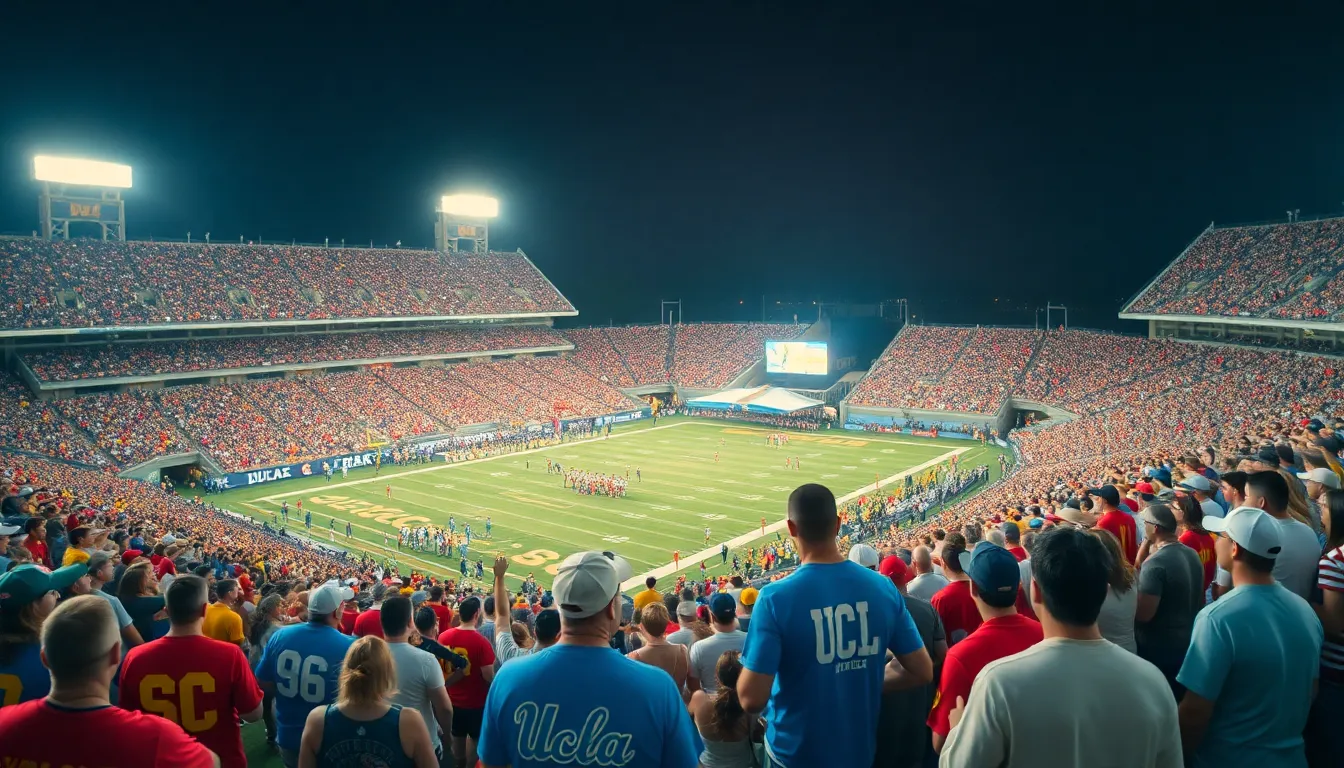When it comes to college football, the Pacific-12 Conference is where the magic happens—or at least where the drama unfolds. Picture this: sun-soaked Saturdays filled with thrilling touchdowns, jaw-dropping plays, and enough school spirit to power a small city. This conference isn’t just about the game; it’s a showcase of talent, tradition, and a dash of rivalry that keeps fans on the edge of their seats.
From the storied programs that have shaped the sport to the underdogs ready to steal the spotlight, the Pac-12 is a melting pot of excitement. Whether you’re a die-hard fan or a casual observer, understanding these teams is like knowing the secret sauce of college football. Buckle up as we dive into the fascinating world of Pac-12 football, where every game is a chance to witness history in the making.
Table of Contents
ToggleOverview of NCAA Pacific-12 Conference Football Teams
The Pacific-12 Conference features twelve prominent universities known for their strong football traditions. Each team adds its unique flair to the conference, fostering intense rivalries and enthusiastic fan bases. Notable programs such as USC and UCLA consistently compete at high levels, showcasing their historical prowess.
Oregon and Stanford frequently challenge for conference titles, emphasizing strategic gameplay and athleticism. Washington and Utah represent the North and South divisions, respectively, contributing to the rich competitive landscape. Additionally, teams like Arizona State and Colorado strive for distinction, seeking opportunities for standout seasons.
Recent data shows strong attendance figures at Pac-12 games, reflecting the passion of fans. Programs consistently develop NFL talent, with numerous alumni making significant impacts in professional leagues. Universities invest heavily in facilities and coaching staff, enhancing the overall football experience for players and supporters alike.
Throughout the season, matchups often attract national attention, showcasing the depth of talent within the conference. Each game offers a stage for emerging stars to shine, further enhancing the competitive nature of Pac-12 football. Off the field, community engagement and student involvement strengthen the connection between the universities and their supporters.
Rivalries within the Pacific-12 Conference enrich the narrative of college football, making each matchup more significant. Annual showdowns, such as “The Duel in the Desert” between Arizona and Arizona State, create lasting memories. By exploring the dynamics of these teams, one gains insight into the vibrant culture surrounding Pac-12 football.
Team Performance Analysis

Analyzing performance trends among Pac-12 football teams reveals rich historical context and demonstrates recent competitive outcomes. Understanding these patterns helps fans appreciate the league’s complexity and dynamics.
Historical Performance Trends
Traditionally, programs like USC and UCLA achieved prominence with numerous conference championships. History shows that Oregon and Stanford competed consistently for top honors, often ranking in national polls. Rivalries defined seasons, impacting performance metrics significantly. Fan engagement increased with each thrilling matchup, showcasing passionate support across the conference. Every decade illustrated shifts in dominance, with emerging teams challenging established powers. Historical performance statistics show that the conference delivered multiple Heisman Trophy winners, emphasizing its talent development abilities.
Recent Season Outcomes
Recent seasons highlight the competitive balance within the Pac-12, with teams like Utah and Washington stepping up in significant ways. Each team exhibited resilience during critical matchups, influencing overall standings. Last season, USC finished with a strong record, showcasing offensive efficiency and defensive strategy. Oregon consistently ranked in the top tier, securing key victories against rivals. Meanwhile, Arizona State and Colorado made strides, improving their standings with notable finishes. Trends in win-loss records reflect the evolving landscape, as emerging teams aim for bowl game appearances and conference title contention.
Key Players to Watch
This section highlights key players in the Pac-12 Conference, showcasing those to watch during the season. Stars from various teams can shape the landscape of college football within the conference.
Offensive Standouts
Quarterback Caleb Williams from USC stands out, showcasing impressive skills and leadership. He garnered the Heisman Trophy and consistently delivers high passing yardage. Running back Oregon’s Bucky Irving makes his mark with explosive plays, regularly finding the end zone. Wide receiver Michael Pittman from UCLA brings speed and agility, having a significant impact on his team’s performance. Additionally, Arizona State’s quarterback Emory Jones shows potential, blending athleticism and play-making ability, specifically in crucial situations. Each of these players enhances their respective offenses, contributing to thrilling games across the conference.
Defensive Stars
Linebacker Eric Gentry from USC plays a pivotal role in stopping opposing offenses. His ability to read plays and tackle effectively secures his team’s defensive strategies. Oregon’s defensive end Kayvon Thibodeaux stands out for his pass-rushing skills, frequently pressuring quarterbacks. Utah’s cornerback Clark Phillips III showcases remarkable coverage abilities, often shutting down the best wide receivers. Safety Jordan Clark from Arizona State brings experience and intelligence, making crucial interceptions throughout the season. These defensive players impact game outcomes, reflecting the competitive nature of the Pac-12.
Coaching Strategies and Changes
Coaching strategies within the Pac-12 Conference evolve continually, reflecting team dynamics and competitive landscapes. Programs adjust their approaches based on player performance and recruitment trends. During recent seasons, innovative offensive schemes have emerged, emphasizing quick passing and versatile running backs. High-tempo offenses have become a hallmark for teams like USC and Oregon, enhancing their scoring capabilities and putting pressure on opposing defenses.
Quarterback training plays a crucial role in this strategy shift. Coaches now prioritize dual-threat quarterbacks who can adapt and extend plays. Programs, including Arizona State and Utah, have embraced this trend, integrating mobile signal-callers into their systems to maximize offensive potential.
Defensive tactics also adapt frequently to counteract these evolving offensive strategies. Teams often switch between aggressive man-to-man coverage and zone schemes based on opponent strengths. Washington and Stanford illustrate these adjustments effectively, deploying flexible defensive line schemes to disrupt the opposing offense.
Additionally, recruiting focuses on skills and adaptability, ensuring players fit into the innovative systems coaches implement. Developing talent through effective training and mentorship remains a key emphasis, particularly at universities like UCLA and Oregon State. Adapting to injury and transfer portal challenges further complicates coaching strategies, requiring dynamic and proactive adjustments from staff.
Cultural elements influence coaching changes as well. Many new coaches emphasize building strong relationships with players to enhance motivation and performance. With the competitive nature of the Pac-12, coaching changes can significantly impact team trajectories. Recent hires across various programs indicate a trend toward prioritizing analytics and player development alongside traditional coaching methods.
Fan Engagement and Support
Fan engagement in the Pac-12 Conference manifests through vibrant game-day atmospheres. Tailgating events draw thousands of passionate supporters who create a festive environment. Alumni and students alike rally around their teams, wearing colors and showing loyalty in various forms. Social media platforms amplify this enthusiasm, enabling fans to share experiences and connect with fellow supporters.
Participation at games reflects the deep-rooted dedication to the teams. In 2022, average attendance exceeded 50,000 fans per game, showcasing the robust support for programs like USC and Oregon. Enthusiasm extends beyond physical attendance, with fans actively engaging in live chats and forums discussing team performances. Contributions such as merchandise sales and donations to athletic programs provide financial backing, fueling future initiatives.
Rivalry games elevate fan interaction to new heights. Iconic matchups, such as USC vs. UCLA, draw intense crowds and create a unique energy that resonates throughout the season. Student sections, known for their creativity and spirit, often lead the charge in generating excitement. Together, they enhance the experience for everyone involved, from casual spectators to lifelong supporters.
Community outreach programs further solidify the bond between teams and their fans. Initiatives promoting youth involvement in sports encourage local engagement and foster future talent. Events featuring players and coaches help build relationships and inspire the next generation. Universities actively collaborate with surrounding communities, reflecting a commitment to shared values and mutual support.
- Social media engagement strengthens connections among fans.
- Game attendance underlines loyalty with consistent turnout.
- Merchandise sales showcase commitment to team identity.
- Rivalry matches foster heightened excitement and participation.
- Community initiatives create lasting local relationships.
The Pacific-12 Conference stands as a dynamic force in college football. Its blend of tradition and innovation keeps fans engaged and teams competitive. With storied rivalries and emerging talents, each season promises thrilling moments that resonate beyond the field.
As programs adapt and evolve, the excitement surrounding Pac-12 football continues to grow. The passionate fan base and vibrant game-day atmosphere highlight the conference’s unique culture. With every matchup, the legacy of Pac-12 football deepens, ensuring its place in the hearts of college sports enthusiasts.




